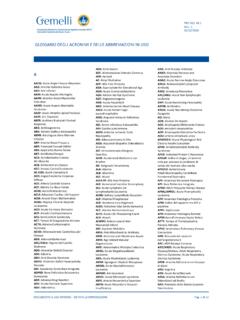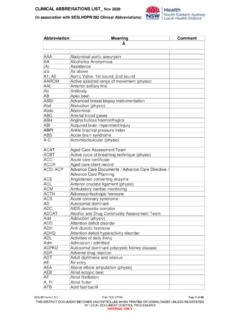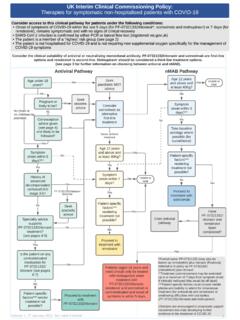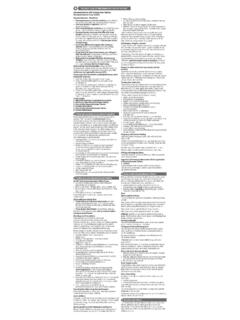Transcription of ANNEX I SUMMARY OF PRODUCT CHARACTERISTICS
1 1 ANNEX I SUMMARY OF PRODUCT CHARACTERISTICS 2 This medicinal PRODUCT is subject to additional monitoring. This will allow quick identification of new safety information. Healthcare professionals are asked to report any suspected adverse reactions. See section for how to report adverse reactions. 1. NAME OF THE MEDICINAL PRODUCT Kymriah x 106 6 x 108 cells dispersion for infusion 2. QUALITATIVE AND QUANTITATIVE COMPOSITION General description Kymriah is an immunocellular therapy containing tisagenlecleucel, autologous T cells genetically modified ex vivo using a lentiviral vector encoding an anti-CD19 chimeric antigen receptor (CAR). Qualitative and quantitative composition Each ethylene vinyl acetate (EVA) infusion bag of Kymriah contains tisagenlecleucel cell dispersion at a batch-dependent concentration of autologous T cells genetically modified to express an anti-CD19 chimeric antigen receptor (CAR-positive viable T cells) (see section ).
2 The concentration of CAR-positive viable T cells is dependent on indication and patient body weight (for B-cell acute lymphoblastic leukaemia [ALL]). The cellular composition and the final cell number varies between individual patient batches. In addition to T cells, NK cells may be present. The quantitative information regarding CAR-positive viable T cells/mL and total cells in the PRODUCT is presented in the batch-specific documentation accompanying Kymriah. 1 or more infusion bags containing a total of x 106 to 6 x 108 CAR-positive viable T cells. Excipient with known effect This medicinal PRODUCT contains mg sodium per mL and to mg sodium per dose. For the full list of excipients, see section 3. PHARMACEUTICAL FORM Dispersion for infusion. A colourless to slightly yellow dispersion. 4. CLINICAL PARTICULARS Therapeutic indications Kymriah is indicated for the treatment of: Paediatric and young adult patients up to and including 25 years of age with B-cell acute lymphoblastic leukaemia (ALL) that is refractory, in relapse post-transplant or in second or later relapse.
3 Adult patients with relapsed or refractory diffuse large B-cell lymphoma (DLBCL) after two or more lines of systemic therapy. 3 Posology and method of administration Kymriah must be administered in a qualified treatment centre. Therapy should be initiated under the direction of and supervised by a healthcare professional experienced in the treatment of haematological malignancies and trained for administration and management of patients treated with Kymriah. Tocilizumab for use in the event of cytokine release syndrome (CRS) and emergency equipment must be available per patient prior to infusion. The treatment centre must have access to additional doses of tocilizumab within 8 hours. In the exceptional case where tocilizumab is not available due to a shortage that is listed in the European Medicines Agency shortage catalogue, suitable alternative measures to treat CRS instead of tocilizumab must be available prior to infusion.
4 Kymriah is intended for autologous use only (see section ). Manufacture and release of Kymriah usually takes about 3-4 weeks. Posology Dosage in paediatric and young adult B-cell ALL patients - For patients 50 kg and below: to 5 x 106 CAR-positive viable T cells/kg body weight. - For patients above 50 kg: to x 108 CAR-positive viable T cells (non-weight based). Dosage in adult DLBCL patients - to 6 x 108 CAR-positive viable T cells (non-weight based). Pre-treatment conditioning (lymphodepleting chemotherapy) Lymphodepleting chemotherapy is recommended to be administered before Kymriah infusion unless the white blood cell (WBC) count within one week prior to infusion is 1,000 cells/ L. Kymriah is recommended to be infused 2 to 14 days after completion of the lymphodepleting chemotherapy. The availability of Kymriah must be confirmed prior to starting the lymphodepleting regimen.
5 If there is a delay of more than 4 weeks between completing lymphodepleting chemotherapy and the infusion and the WBC count is >1,000 cells/ L, then the patient should be re-treated with lymphodepleting chemotherapy prior to receiving Kymriah. B-cell ALL The recommended lymphodepleting chemotherapy regimen is: - Fludarabine (30 mg/m2 intravenous daily for 4 days) and cyclophosphamide (500 mg/m2 intravenous daily for 2 days starting with the first dose of fludarabine). If the patient experienced a previous Grade 4 haemorrhagic cystitis with cyclophosphamide, or demonstrated a chemorefractory state to a cyclophosphamide-containing regimen administered shortly before lymphodepleting chemotherapy, then the following should be used: - Cytarabine (500 mg/m2 intravenous daily for 2 days) and etoposide (150 mg/m2 intravenous daily for 3 days starting with the first dose of cytarabine). DLBCL The recommended lymphodepleting chemotherapy regimen is: - Fludarabine (25 mg/m2 intravenous daily for 3 days) and cyclophosphamide (250 mg/m2 intravenous daily for 3 days starting with the first dose of fludarabine).
6 If the patient experienced a previous Grade 4 haemorrhagic cystitis with cyclophosphamide, or demonstrated a chemorefractory state to a cyclophosphamide-containing regimen administered shortly before lymphodepleting chemotherapy, then the following should be used: - Bendamustine (90 mg/m2 intravenous daily for 2 days). Lymphodepleting chemotherapy may be omitted if a patient s white blood cell (WBC) count is 1,000 cells/ L within 1 week prior to Kymriah infusion. 4 Pre-medication To minimise potential acute infusion reactions, it is recommended that patients be pre-medicated with paracetamol and diphenhydramine or another H1 antihistamine within approximately 30 to 60 minutes prior to Kymriah infusion. Corticosteroids should not be used at any time except in the case of a life-threatening emergency (see section ). Clinical assessment prior to infusion Kymriah treatment should be delayed in some patient groups at risk (see section ).
7 Monitoring after infusion - Patients should be monitored daily for the first 10 days following infusion for signs and symptoms of potential cytokine release syndrome, neurological events and other toxicities. Physicians should consider hospitalisation for the first 10 days post infusion or at the first signs/symptoms of cytokine release syndrome and/or neurological events. - After the first 10 days following the infusion, the patient should be monitored at the physician s discretion. - Patients should be instructed to remain within proximity (within 2 hours of travel) of a qualified clinical facility for at least 4 weeks following infusion. Special populations Paediatric population B-cell ALL: No formal studies have been performed in paediatric patients below 3 years of age. DLBCL: The safety and efficacy of Kymriah in children and adolescents below 18 years of age have not yet been established.
8 No data are available. Elderly B-cell ALL: The safety and efficacy of Kymriah in this population have not been established. DLBCL: No dose adjustment is required in patients over 65 years of age. Patients seropositive for hepatitis B virus (HBV), hepatitis C virus (HCV), or human immunodeficiency virus (HIV) There is no experience with manufacturing Kymriah for patients with a positive test for HIV, active HBV, or active HCV infection. Leukapheresis material from these patients will not be accepted for Kymriah manufacturing. Screening for HBV, HCV, and HIV must be performed in accordance with clinical guidelines before collection of cells for manufacturing. Method of administration Kymriah is for intravenous use only. Precautions to be taken before handling or administering the medicinal PRODUCT This medicinal PRODUCT contains genetically modified human blood cells. Healthcare professionals handling Kymriah should take appropriate precautions (wearing gloves and glasses) to avoid potential transmission of infectious diseases as for any human-derived material.
9 Preparation for infusion Prior to Kymriah infusion, it must be confirmed that the patient s identity matches the essential unique patient information on the infusion bag(s). The timing of thaw of Kymriah and infusion should be coordinated. Please refer to section for details on inspection and thawing of the infusion bag. The infusion start time should be confirmed in advance and adjusted for thaw so that Kymriah is available for infusion when the recipient is ready. Once Kymriah has been thawed and is at room temperature (20 C -25 C), it should be infused within 30 minutes to maintain maximum PRODUCT viability, including any interruption during the infusion. 5 Administration Kymriah should be administered as an intravenous infusion through latex-free intravenous tubing without a leukocyte depleting filter, at approximately 10 to 20 mL per minute by gravity flow. All contents of the infusion bag(s) should be infused.
10 Sodium chloride 9 mg/mL ( ) solution for injection should be used to prime the tubing prior to infusion and to rinse it after infusion. When the full volume of Kymriah has been infused, the infusion bag should be rinsed with 10 to 30 mL sodium chloride 9 mg/mL ( ) solution for injection by back priming to ensure as many cells as possible are infused into the patient. If the volume of Kymriah to be administered is 20 mL, intravenous push may be used as an alternative method of administration. For special precautions for disposal see section Contraindications Hypersensitivity to the active substance or to any of the excipients listed in section Contraindications of the lymphodepleting chemotherapy must be considered. Special warnings and precautions for use Traceability To ensure traceability the name of the PRODUCT , the batch number and the name of the treated patient should be kept for a period of 30 years.















